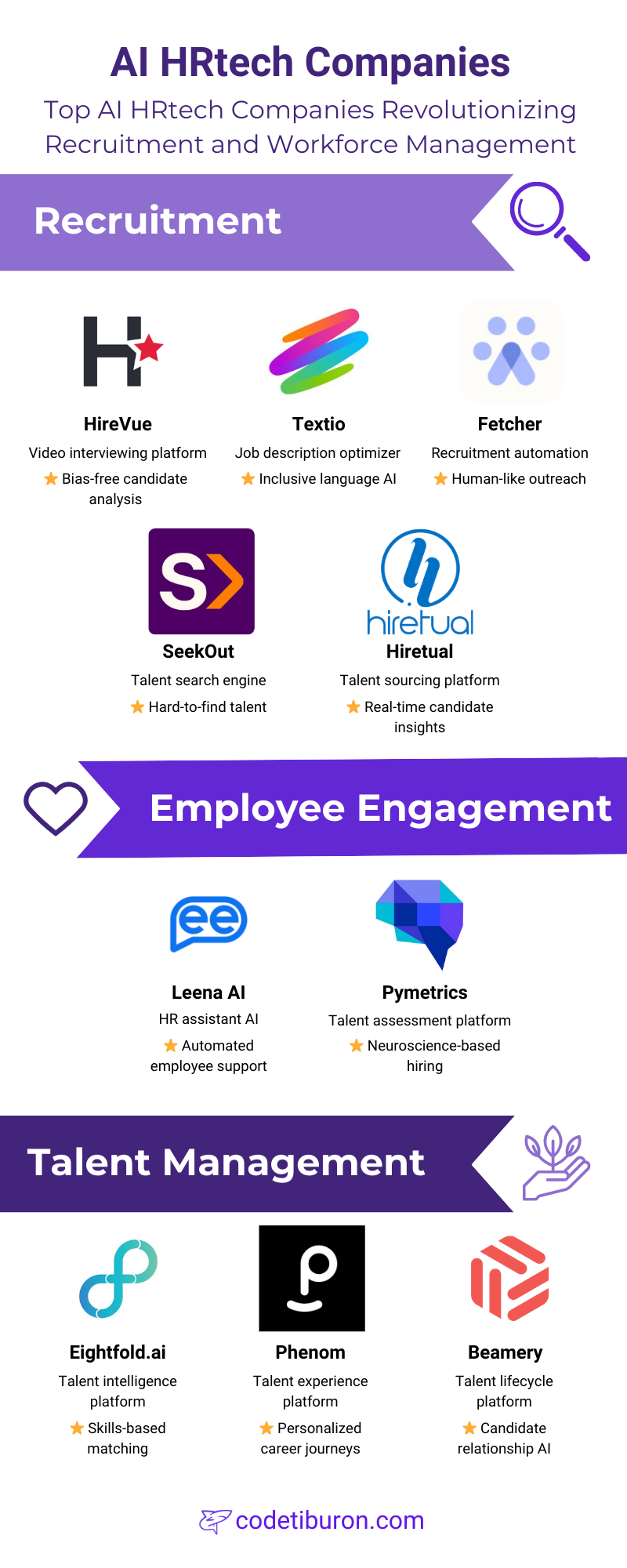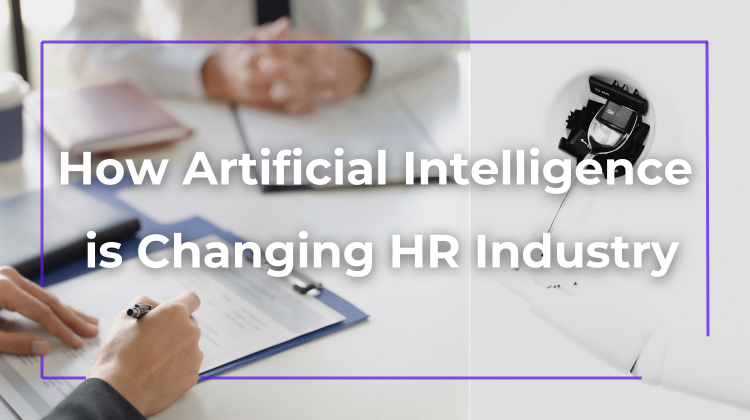While industries have been adopting technology to curb the unprecedented global volatility, uncertainty, complexity, and ambiguity (VUCA), the advent of artificial intelligence is taking us to a whole new level. McKinsey describes the future of work with AI as ‘VUCA on steroids’.
With this new challenge, how can we ensure that AI-enhanced software efficiently tackles the recruitment industry challenges?
*This is an update of the 2020 article due to the fast-evolving tech landscape.
The plan
Artificial intelligence adoption is growing in HR and recruitment
The AI HRtech landscape is growing. Josh Bersin lists 30 trailblazers. Even though not all can win this race, some companies are starting to make a splash in HR and recruitment with their innovative AI-enhanced solutions.

Read also: Recruitment App Development: Digitalization Case Study Overview.
AI is already making impact in some HR functions
Let’s analyse the five key areas where AI is making a difference.
Resume screening and candidate matching
AI-powered tools like Greenhouse and Lever analyze resumes and match candidates to job descriptions with remarkable accuracy. These systems go beyond keywords, assessing skills, experience, and even cultural fit. The result? A 50% reduction in time spent screening resumes, according to industry reports.
Chatbots for candidate engagement
AI chatbots like Mya (recently acquired by StepStone Group) and Olivia by Paradox are revolutionizing candidate communication. They answer questions, schedule interviews, and provide real-time updates, creating a seamless experience. Companies using chatbots report a 40% improvement in candidate engagement, ensuring top talent stays interested throughout the hiring process.
Interview automation
Platforms like HireVue and Pymetrics use AI to analyze video interviews, assessing tone, facial expressions, and language. This not only speeds up hiring but also provides insights into candidate suitability. However, ethical concerns around bias and transparency remain, requiring careful oversight.
Predictive analytics for hiring decisions
AI tools like Eightfold AI and Beamery use predictive analytics to forecast candidate success and retention. By analyzing historical data, these tools help HR teams make data-driven decisions, considerably reducing turnover.
Employee onboarding and training
AI is personalizing onboarding and development. Platforms like Talmundo and EdCast create tailored onboarding experiences and recommend training programs based on individual needs. This not only boosts employee satisfaction but also accelerates time-to-productivity.
Transformative power of artificial intelligence in HR and recruitment
As organizations increasingly outsource repetitive HR tasks to AI, the benefits are becoming impossible to ignore. From slashing hiring timelines to fostering diversity, AI is reshaping how companies attract, hire, and retain talent. But what exactly makes AI so transformative? Let’s dive into the data and insights that highlight its game-changing impact.
Efficiency and speed
AI helps automate time-consuming tasks, allowing HR teams to focus on applicants. Tools like HireVue and Mya streamline resume screening and interview scheduling, reducing time-to-hire by up to 75%. This isn’t just about speed—it’s about ensuring top talent doesn’t slip through the cracks. Companies leveraging AI report a 30% improvement in recruitment efficiency, making it a bargain for competitive hiring.
Improved candidate experience
In a job market where candidate experience can make or break a hire, AI is stepping up. Platforms like Olivia use AI-powered chatbots to provide instant responses to candidate queries, keeping applicants informed and engaged throughout the hiring process. This frictionless communication boosts candidate experience and takes care of the company image, making companies more attractive to top talent.
Bias reduction (when done right)
One of AI’s most promising benefits is its potential to reduce bias in hiring. Tools like Textio craft inclusive job descriptions, while platforms like Eightfold.ai anonymize resumes and focus on skills rather than demographics. According to a Stanford study, companies using AI for bias reduction see an increase in workforce diversity. A point in case is Atlassian, whose percentage of women among new recruits has increased from 18% to 57% thanks to Textio.
Data-driven decision making
AI is turning HR into a data-driven function, enabling smarter hiring and workforce planning. Predictive analytics tools like Beamery and Visier analyze historical data to forecast candidate success and retention rates. Organizations using AI for workforce analytics report a 27% improvement in employee performance. By identifying trends and gaps, AI empowers HR teams to make informed, strategic decisions about talent acquisition and development.
Personalized onboarding and development
AI may not just transform hiring but help with onboarding. Platforms like Talmundo create personalized onboarding experiences, helping new hires feel connected from day one. Meanwhile, AI-driven learning tools like EdCast recommend tailored training programs based on individual skills and career goals.
Cost savings
Beyond improving outcomes, AI is a significant cost optimizer. By automating manual processes, tools like those used by Unilever are saving millions in recruitment costs. AI ensures recruiters spend time on high-value tasks, maximizing productivity and ROI. For organizations looking to optimize their HR budgets, AI is more than just an option.
With AI advancement, the benefits will only grow, making it an indispensable tool for forward-thinking organizations. However, as with any technology, its risks must be clearly understood and anticipated. Let’s explore those next.
Potential risks of AI implementation and how to avert them
As AI continues transforming the HR industry, we’ll be facing unprecedented challenges.
Algorithm bias
This poses a significant risk. If trained on biased data, algorithms can perpetuate or even amplify existing inequalities. For example, Amazon’s AI recruiting tool was scrapped after it showed bias against women. To prevent this, organizations must ensure AI tools are trained on diverse datasets and regularly audited for fairness, while involving diverse teams in development and testing.
Loss of human touch
Over-reliance on AI can make candidates feel like just another data point. While chatbots and automated systems are efficient, they lack the empathy and intuition of human recruiters. Thus striking a balance is important. Why not use AI for repetitive tasks like scheduling and screening, while ensuring recruiters handle personalized interactions and final decisions? Candidates value the human connection above all.
Ethical and privacy concerns
As AI tools that analyze facial expressions, tone, or social media profiles, candidates may feel uncomfortable being scrutinized by algorithms. Transparency and consent are critical here—clearly communicating how AI is used, obtaining explicit consent, and adhering to data privacy regulations like GDPR can build trust and protect candidate privacy.
Read also: How to Build an Applicant Tracking System [Enterprise Use Case].
High costs
The high implementation costs of AI can be a barrier, especially for smaller companies. While AI can save money in the long run, the initial investment in tools, training, and integration can be daunting. Starting small with modular solutions that address specific pain points, like resume screening or candidate communication, can make AI adoption more accessible and scalable for organizations of all sizes.
Over-reliance on technology
AI is only as good as the data it’s trained on. Poorly calibrated algorithms might reject highly qualified candidates who don’t fit the “ideal” profile. To avoid this, recruiters should use AI as a tool rather than a decision-maker, reviewing its recommendations and applying their judgment. Regularly updating AI models based on real-world outcomes can also improve accuracy.
Conclusion
AI can make things easier in HR and recruitment, but it’s not a silver bullet. The risks are real and should not be taken lightly. Fairness, transparency, and human connection are paramount in business as in life. The key to success lies in striking the right balance between technology and humanity. After all, the goal of AI in HR isn’t to replace people but empower them to do their best work.


This is such a nice content! Will look forward for more. Totally for the mind!
Thank you for your appreciation, Leo John!